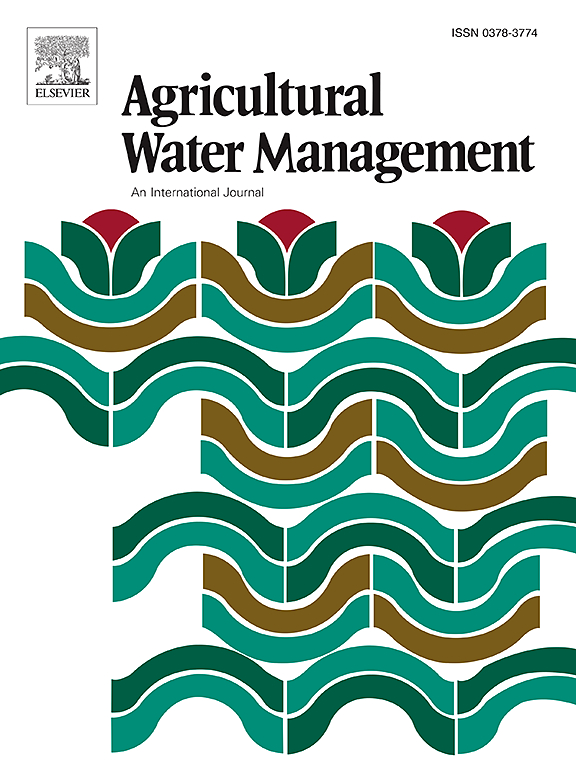A hybrid variable flux irrigation model for mitigating agroecological impacts of straw incorporation and furrow ridge system in rice-wheat rotations
IF 5.9
1区 农林科学
Q1 AGRONOMY
引用次数: 0
Abstract
Shifting from traditional puddled transplanted rice to mechanized drilled-seeding, combined with rotary straw mixing and furrow irrigation, has proven to be a crucial strategy for reducing methane emissions while optimizing resource utilization and productivity. However, this technique introduces other challenges, such as furrow runoff and soil erosion, which contribute to the degradation of ridge/bed soil quality, fertilizer loss, and transport of agroecological pollutants. Therefore, this study explores a hybrid variable flux irrigation (VFI) model as a decision support tool to mitigate these limitations by controlling soil anoxia and runoff in furrow-irrigated rice after straw incorporation. The approach integrates the Hydrus 2D/3D with optimal loop controllers to adjust pump operations based on specific soil moisture levels, variable flux, and furrow water flow depths. Experimental validation and a field case study were conducted in Babaiqiao, Nanjing City, China, where rotary straw mixing and furrow-ridge layouts were applied alongside dry rice seeding and soil hydraulic experiments. The performance indicators of the Hydrus 2D/3D variable flux demonstrated reliable simulation of lateral wetting rates and soil moisture content with R2 of 0.79 and 0.89, corresponding RMSE values of 7.90 % and 7.60 %, and MRE values of 1.85 m/day and 0.07 cm³/cm³, respectively. The VFI model proved effective, indicating that the optimal irrigation schedule consisted of three distinct supply regimes. During each cycle, the pump operated intermittently, running for approximately 2.66 hours. VFI led to a 33 % reduction in pumping energy costs while simultaneously mitigating soil anoxia and furrow runoff, thus a potential to reduce the environmental footprint of rice-wheat rotations. Although rice yields under drilled seeding were reduced by 9.56 % compared to flood irrigation due to heavy weed infestation, the VFI model provides valuable insights for promoting straw incorporation and implementing practical solutions that support optimal water utilization and sustainable productivity.
用于减轻稻麦轮作中秸秆掺入和沟垄系统对农业生态影响的混合可变通量灌溉模型
事实证明,从传统的水田插秧转变为机械化钻孔播种,并结合旋耕秸秆搅拌和沟灌,是减少甲烷排放、优化资源利用和提高生产率的重要战略。然而,这项技术也带来了其他挑战,如沟渠径流和水土流失,从而导致田埂/田床土壤质量下降、肥料流失和农业生态污染物迁移。因此,本研究探索了一种混合可变通量灌溉(VFI)模型,作为决策支持工具,通过控制秸秆掺入后沟灌水稻的土壤缺氧和径流来缓解这些限制。该方法将 Hydrus 2D/3D 与优化环路控制器相结合,根据特定的土壤湿度水平、可变通量和沟渠水流深度调整水泵运行。在中国南京市八佰桥进行了实验验证和田间案例研究,在进行旱稻播种和土壤水力实验的同时,还应用了旋转式秸秆混合和沟垄布局。Hydrus 2D/3D 可变通量的性能指标显示了对侧向湿润率和土壤含水量的可靠模拟,R2 分别为 0.79 和 0.89,相应的 RMSE 值分别为 7.90 % 和 7.60 %,MRE 值分别为 1.85 m/day 和 0.07 cm³/cm³。VFI 模型证明是有效的,表明最佳灌溉计划由三个不同的供水系统组成。在每个周期中,水泵间歇运行,运行时间约为 2.66 小时。VFI 降低了 33% 的水泵能源成本,同时减轻了土壤缺氧和沟渠径流,因此有可能减少水稻-小麦轮作的环境足迹。虽然由于杂草丛生,水稻穴播产量比漫灌减少了 9.56%,但 VFI 模型为推广秸秆还田和实施实际解决方案提供了宝贵的见解,有助于优化水资源利用和提高可持续生产力。
本文章由计算机程序翻译,如有差异,请以英文原文为准。
求助全文
约1分钟内获得全文
求助全文
来源期刊

Agricultural Water Management
农林科学-农艺学
CiteScore
12.10
自引率
14.90%
发文量
648
审稿时长
4.9 months
期刊介绍:
Agricultural Water Management publishes papers of international significance relating to the science, economics, and policy of agricultural water management. In all cases, manuscripts must address implications and provide insight regarding agricultural water management.
 求助内容:
求助内容: 应助结果提醒方式:
应助结果提醒方式:


